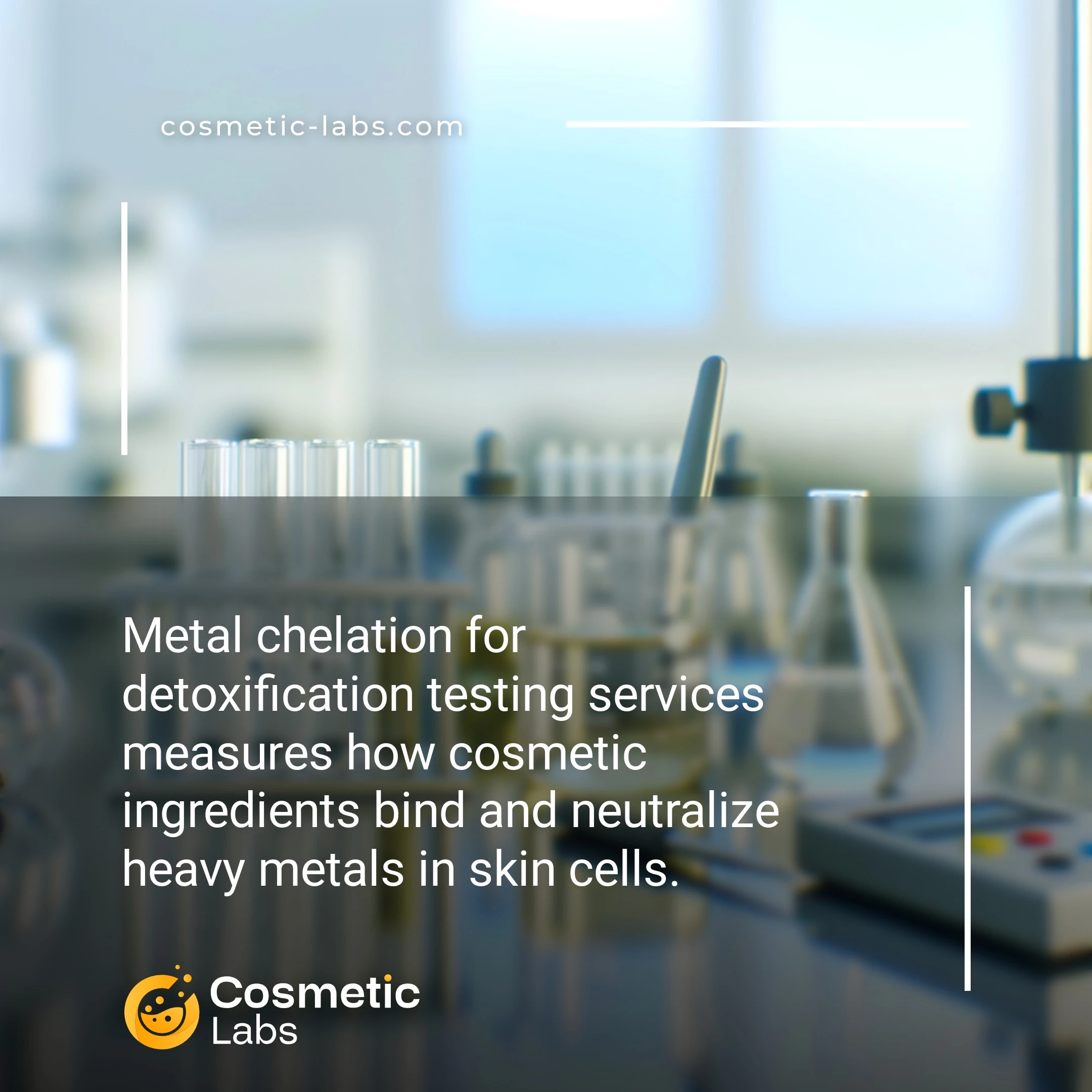Metal Chelation Testing Services for Cosmetic Detox Claims

What is Metal chelation?
Metal chelation for detoxification testing services is a specialized laboratory assessment that measures how effectively cosmetic ingredients bind and neutralize heavy metals like lead, mercury, and cadmium from skin cells. Labs use in vitro assays with synthetic skin models to evaluate your formulation’s ability to capture environmental pollutants, providing concrete data on detoxification efficacy. This testing reveals whether your anti-pollution claims hold up scientifically—many brands discover their formulations need chelating agents like EDTA or citric acid to achieve meaningful results.
Why do you need this service?
Beauty brands use metal chelation testing to validate their anti-pollution skincare claims, measuring how effectively products bind and neutralize heavy metals like lead, mercury, and cadmium from urban environments. Labs conduct these assays on serums, creams, and cleansers to generate concrete efficacy data that supports marketing messages about environmental protection and detoxification benefits.
Who provides Metal chelation services?
All cosmetic labs providing Metal chelation services
There is no company providing these services at the moment.
Metal Chelation Testing for Detoxification Cosmetics
Metal chelation testing validates your cosmetic product’s ability to bind and neutralize heavy metals that accumulate on skin from environmental pollution. This specialized testing builds on pollutant protection protocols by measuring how effectively your formulation removes metallic contaminants like lead, mercury, and cadmium from skin surfaces.
Chelation Efficacy Assessment
Labs run in vitro chelation assays using standardized metal solutions to quantify your product’s binding capacity. These tests measure chelation rates across different pH levels and exposure times. The process involves:
- Metal binding kinetics analysis over 24-48 hour periods
- Chelation stability testing under various temperature conditions
- Competitive binding studies with multiple metal types
- Quantitative analysis using atomic absorption spectroscopy
Results show precise chelation percentages and help optimize your formulation’s metal-binding ingredients like EDTA, citric acid, or peptide complexes.
Skin Penetration and Safety Validation
Testing labs evaluate how chelated metal complexes interact with skin barriers using Franz diffusion cells and artificial skin models. This ensures your product removes metals without causing irritation or unwanted penetration.
- Transepidermal water loss measurements during chelation
- Cytotoxicity screening of chelated metal complexes
- Skin compatibility testing with chelating agents
- Residual metal analysis on treated skin samples
These studies confirm your detox product works safely while maintaining skin integrity. Contact labs on our platform to discuss metal chelation testing protocols that match your specific formulation needs.
Metal Chelation Testing Applications for Cosmetic Product Development
Cosmetic labs deploy metal chelation testing for detoxification to validate products that protect skin from environmental pollutants and heavy metal exposure.
Anti-Pollution Skincare Formulation Testing
Labs evaluate chelating agents like EDTA, citric acid, and phytic acid in serums and moisturizers designed to neutralize heavy metals. Testing protocols measure copper, iron, and zinc binding capacity using spectrophotometry and atomic absorption methods. Chelation efficacy testing determines optimal concentrations for removing metal ions from skin surface while maintaining product stability.
Product developers receive detailed binding affinity data within 2-3 weeks, enabling formulation adjustments before manufacturing. Labs also test pH stability and compatibility with active ingredients to prevent chelator degradation.
Urban Defense Product Claims Validation
Cosmetic brands launching “city shield” or “pollution defense” products require substantiation testing for marketing claims. Labs conduct metal ion removal assays using synthetic pollutant solutions that mimic urban environmental exposure. Testing includes lead, cadmium, and mercury chelation measurements under controlled conditions.
Validation studies typically span 4-6 weeks and include stability testing at various temperatures. Labs provide comprehensive reports supporting specific percentage claims about metal removal effectiveness.
| Chelating Agent | Primary Metals Targeted | Testing Method | Typical Concentration Range |
|---|---|---|---|
| EDTA | Copper, Iron, Calcium | Spectrophotometry | 0.1-1.0% |
| Citric Acid | Iron, Copper | Atomic Absorption | 0.5-2.0% |
| Phytic Acid | Iron, Zinc, Copper | Complexometric Titration | 0.2-0.8% |
| Gluconic Acid | Calcium, Magnesium | Ion Chromatography | 1.0-3.0% |
Ready to validate your detoxification claims? Contact specialized cosmetic labs on our platform for metal chelation testing services tailored to your product development needs.
